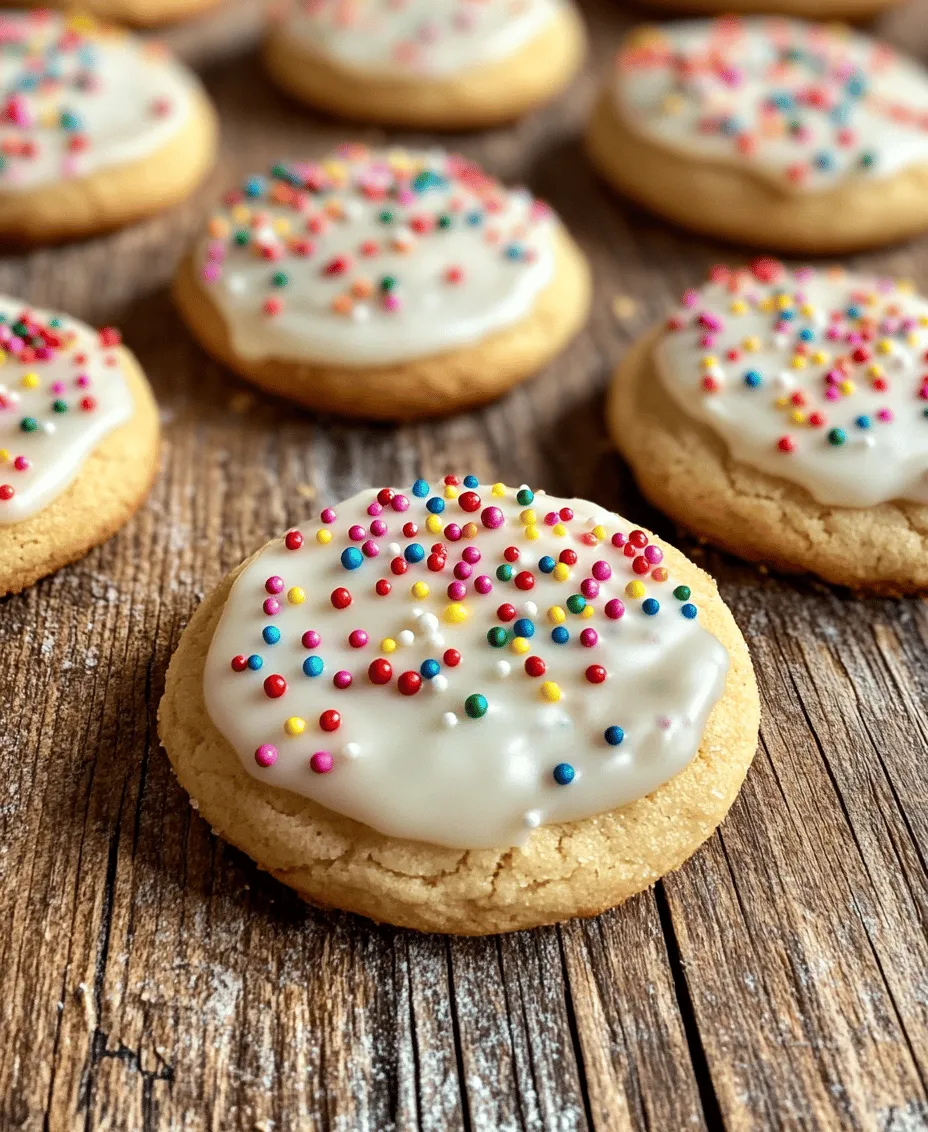Introduction
Christmas is a time steeped in tradition, and in Italy, one of the most cherished customs is the baking of Christmas cookies. These delightful treats are not just delicious; they evoke a sense of nostalgia and warmth that permeates the holiday season. Each year, families gather in their kitchens, flour dusting the countertops, as they mix ingredients, roll dough, and shape cookies that will soon fill their homes with the sweet aromas of the holidays. The act of baking together fosters connections across generations, making these cookies a symbol of love, family, and festive cheer.
The recipe we are about to explore—Sweet Nostalgia: Italian Christmas Cookies—celebrates this rich tradition. With a medley of textures and flavors, these cookies are inspired by the diverse regional variations found throughout Italy. From the delicate almond flavors to the zesty hints of lemon, each bite is a delightful trip down memory lane, reminding us of cozy family gatherings and festive celebrations.
In the following sections, we will delve into the heart of these cookies, exploring their historical significance, the unique ingredients that create their delightful flavors, and the step-by-step instructions to make your own batch.
The Tradition of Italian Christmas Cookies
The history of Italian Christmas cookies is as rich and varied as the regions of Italy themselves. Each area has its own unique recipes, often passed down through generations, with families adding their own twists to create beloved holiday treats. These cookies, known as “biscotti di Natale,” are typically prepared in the weeks leading up to Christmas, with many families hosting cookie-making days where the entire clan comes together.
Culturally, cookies play an essential role in festive gatherings. They are not just desserts but are often presented as gifts, shared among friends and family, and served at holiday parties. In many Italian households, the cookie tray is a centerpiece of the Christmas celebration, showcasing an array of colorful and beautifully decorated cookies. From soft and chewy varieties to crisp and crumbly treats, the assortment reflects the love and creativity of those who bake them.
Across Italy, you’ll find regional variations that highlight local ingredients and traditions. For instance, in the South, you might come across “Struffoli,” small fried dough balls drizzled with honey, while in the North, “Panettone” reigns supreme, a sweet bread filled with candied fruit. Yet, the Christmas cookie remains a staple throughout the country, embodying the spirit of the season and the joy of sharing.
Ingredients Breakdown
To create the perfect batch of Italian Christmas cookies, it’s essential to understand the role of each ingredient in the recipe. Here’s a detailed analysis of the key components that contribute to the cookies’ delightful texture and flavor.
Flour
At the base of any cookie recipe is flour, and for our Italian Christmas cookies, all-purpose flour is a staple. This type of flour provides the right amount of gluten, ensuring that the cookies have a tender yet sturdy structure. The balance of protein in all-purpose flour allows the cookies to rise appropriately while still maintaining a soft, chewy interior. For those looking to experiment, using almond flour can introduce a nutty flavor and a hint of moisture, making for a delightful variation.
Sugar
Sugar is the heart of sweetness in our cookies, and we’ll be using both granulated sugar and confectioners’ sugar in this recipe. Granulated sugar not only sweetens the cookies but also contributes to their texture, helping them to spread and crisp up during baking. On the other hand, confectioners’ sugar, also known as powdered sugar, is essential for the icing. It creates a smooth, glossy finish that enhances both the appearance and taste of the cookies, adding a touch of sweetness without being overly heavy.
Baking Powder and Salt
Baking powder is a crucial ingredient in our cookie recipe, acting as a leavening agent that helps the cookies rise. It introduces air into the dough, resulting in a light and fluffy texture that contrasts beautifully with the crisp edges. Salt, though often overlooked, plays a significant role in balancing flavors. A pinch of salt elevates the sweetness and enhances the overall taste, ensuring the cookies are well-rounded in flavor.
Butter
Butter is a key ingredient in baking, and for our Italian cookies, using unsalted butter is recommended. Unsalted butter allows for better control over the salt content in the recipe, ensuring that the cookies are not overly salty. Additionally, the fat content in butter contributes to a rich, flavorful cookie with a tender crumb. When creamed with sugar, butter provides a light and airy texture that is essential for achieving the perfect cookie consistency.
Eggs
Eggs are another foundational ingredient, contributing to the structure and moisture of the cookies. They act as a binding agent, holding the dough together while also adding richness. The proteins in eggs help to create a sturdy cookie that holds its shape during baking. For a more delicate texture, consider using room temperature eggs, as they incorporate more easily into the batter.
Flavorings
The flavor profile of Italian Christmas cookies is enhanced by a variety of flavorings. Traditional recipes often include vanilla extract, almond extract, and lemon zest. Vanilla offers a warm, sweet aroma that complements the other flavors, while almond extract adds a nutty depth that is characteristic of many Italian desserts. Lemon zest provides a refreshing brightness that cuts through the sweetness, creating a balanced and delightful taste.
Icing Ingredients
Finally, we come to the icing that will adorn our cookies. The icing mixture is simple yet effective, typically made with confectioners’ sugar and a splash of milk or water to achieve the desired consistency. This icing not only adds a sweet touch but also serves as a canvas for decorations and festive designs. With a smooth finish, the icing enhances the aesthetic appeal of the cookies, making them perfect for holiday gatherings.
Step-by-Step Instructions
Now that we have an understanding of the ingredients and their roles, let’s dive into the step-by-step instructions to create these delightful Italian Christmas cookies.
1. Preheat the Oven: Begin by preheating your oven to 350°F (175°C). This ensures that the cookies bake evenly and develop a beautiful golden color.
2. Prepare the Baking Sheets: Line two baking sheets with parchment paper. This will prevent the cookies from sticking and make for easy cleanup.
3. Mix the Dry Ingredients: In a medium bowl, whisk together the all-purpose flour, baking powder, and salt. This step helps to evenly distribute the leavening agent and salt throughout the flour.
4. Cream Butter and Sugar: In a large mixing bowl, cream together the unsalted butter and granulated sugar until light and fluffy. This process usually takes about 3-5 minutes with an electric mixer on medium speed.
5. Add Eggs and Flavorings: Beat in the eggs one at a time, ensuring each is fully incorporated before adding the next. Then, mix in the vanilla extract, almond extract, and lemon zest. This step infuses the dough with the delightful flavors that characterize Italian Christmas cookies.
6. Combine Wet and Dry Ingredients: Gradually add the dry ingredient mixture to the wet ingredients, mixing until just combined. Be careful not to overmix, as this can lead to tough cookies.
7. Shape the Cookies: Using a cookie scoop or your hands, portion out the dough into small balls (about one inch in diameter) and place them on the prepared baking sheets, leaving space between each for spreading.
8. Bake: Place the baking sheets in the preheated oven and bake for 10-12 minutes, or until the edges are lightly golden. Keep an eye on them, as baking times may vary based on your oven.
9. Cool the Cookies: Once baked, remove the cookies from the oven and allow them to cool on the baking sheets for about 5 minutes before transferring them to wire racks to cool completely.
10. Prepare the Icing: While the cookies cool, prepare the icing by mixing confectioners’ sugar with a small amount of milk or water until you achieve a smooth, spreadable consistency.
11. Decorate: Once the cookies are completely cooled, drizzle or spread the icing over the top. You can also add festive sprinkles or edible decorations to enhance their holiday appeal.
These cookies are not just a treat; they’re a celebration of Italian heritage and family tradition. As you bake and decorate, you’ll find yourself immersed in the spirit of the season, creating memories that will last a lifetime.
Stay tuned for the next part of this article, where we’ll delve deeper into tips for achieving the best results and answer some common questions about these delightful Italian Christmas cookies.

Preheating the Oven: The Importance of Proper Oven Temperature
Before diving into the mixing and baking of your Italian Christmas cookies, it’s crucial to preheat your oven properly. The importance of this step cannot be overstated, as the right temperature ensures even baking and helps your cookies rise to perfection. Set your oven to 350°F (175°C) and allow it to preheat for at least 15-20 minutes. This will create an optimal baking environment, allowing the cookies to develop their full flavor and texture. An unpreheated oven can lead to uneven baking, resulting in cookies that are either burnt on the edges or undercooked in the center.
Mixing Dry Ingredients: Tips on Achieving a Uniform Blend
The next step involves preparing your dry ingredients. In a medium bowl, combine all-purpose flour, baking powder, and a pinch of salt. To ensure an even distribution of the leavening agents, whisk the dry ingredients together thoroughly. This step is essential for achieving a light and fluffy cookie texture. Consider using a sifter for an extra fine blend, especially if your flour has been sitting in the pantry for a while, as this can help aerate it and remove any lumps.
Creaming Butter and Sugar: Techniques for Achieving the Right Texture
Now, turn your attention to the butter and sugar. In a large mixing bowl, use a hand mixer or stand mixer to cream together 1 cup of softened unsalted butter and 1 cup of granulated sugar until the mixture is light and fluffy. This process typically takes about 3-5 minutes. The key here is to incorporate air into the butter, which will help the cookies rise and create a tender texture. Once the mixture appears pale and fluffy, it’s time to add your eggs.
Incorporating Eggs and Flavors: Importance of Mixing Methods
Add in two large eggs, one at a time, mixing well after each addition. This gradual incorporation helps the eggs blend seamlessly into the butter and sugar mixture. After the eggs are fully mixed in, add your vanilla extract and almond extract. These flavors are essential for giving your Italian Christmas cookies that nostalgic taste. Mix until just combined—overmixing at this stage can lead to denser cookies.
Combining Wet and Dry Ingredients: Recognizing the Right Dough Consistency
It’s time to combine your wet and dry ingredients. Gradually add the dry mixture into the wet ingredients, stirring gently with a spatula or wooden spoon. Be careful not to over-mix; stop when you see no pockets of flour remaining. The dough should be soft and slightly sticky but hold its shape when formed. If it feels too wet, you can add a tablespoon of flour at a time until the desired consistency is reached.
Shaping the Cookies: Best Practices for Uniform Cookie Sizes
For uniformity, it’s best to use a cookie scoop or tablespoon to measure out your dough. Roll each portion into a ball and place them on a lined baking sheet, leaving enough space between each cookie to allow for spreading. If you prefer a more decorative shape, you can flatten the balls slightly with the palm of your hand or the bottom of a glass before baking. This technique helps ensure even cooking and a beautiful presentation.
Baking Cookies: Understanding Baking Times and Indicators of Doneness
Once all your cookies are shaped and ready, place the baking sheet in the preheated oven. Bake for 10-12 minutes, or until the edges are lightly golden. It’s important to keep an eye on them, as baking times may vary depending on your oven. A good indicator of doneness is when the tops look set and slightly puffed. Removing them from the oven while they still look a bit underbaked will allow them to continue cooking on the baking sheet for a minute or two, achieving a perfect chewy center.
Preparing the Icing: Tips on Achieving a Smooth Icing Consistency
While your cookies are cooling, you can prepare the icing. In a clean mixing bowl, whisk together powdered sugar and milk until you reach a smooth and pourable consistency. For added flavor, a splash of vanilla extract can be mixed in. If your icing is too thick, gradually add more milk until you achieve your desired consistency. If it’s too thin, simply add more powdered sugar. This icing will not only enhance the flavor but also create a beautiful glossy finish on your cookies.
Adding Sprinkles: Creative Ideas for Decorating Cookies
Once the icing is ready, dip the tops of your cooled cookies into the icing or drizzle it over them using a spoon. While the icing is still wet, add your favorite sprinkles, colored sugars, or edible glitter for a festive touch. Consider using seasonal colors to match the holiday theme, or mix and match for a more playful approach. Let the icing set completely before stacking or storing the cookies.
Baking Tips for Perfect Cookies
Common Pitfalls to Avoid When Baking Cookies
Baking cookies, while seemingly straightforward, can come with its own set of challenges. Common pitfalls include not measuring ingredients accurately, which can lead to cookies that are too dry or too wet. Always use the spoon-and-level method for measuring flour and other dry ingredients. Another mistake is not allowing the butter to soften adequately. Cold butter will not cream well with sugar, resulting in dense cookies.
How to Store Cookies for Maximum Freshness
To keep your Italian Christmas cookies fresh, store them in an airtight container at room temperature. If you’ve made a large batch, consider freezing some for future enjoyment. Place layers of cookies between sheets of parchment paper in a freezer-safe container. They can last up to three months in the freezer. When you’re ready to enjoy them, simply thaw at room temperature for a few hours.
Suggestions for Variations in Flavor and Decoration
Feel free to experiment with the flavors and decorations of your cookies. Instead of almond extract, try substituting with lemon or orange zest for a citrusy twist. You can also mix in chocolate chips, nuts, or dried fruits for added texture and flavor. For decoration, consider using melted chocolate instead of icing, or dusting with powdered sugar for a simple yet elegant touch.
The Joy of Sharing: Cookies as Gifts
The Tradition of Gifting Homemade Cookies During the Holidays
One of the most cherished traditions during the holidays is the gifting of homemade cookies. Sharing your Italian Christmas cookies with friends, family, and neighbors spreads joy and warmth. Consider baking a few extra batches to share with those who might need a little extra cheer during the season. Homemade cookies carry personal touches that store-bought treats simply can’t match.
Creative Packaging Ideas for Gifting Cookies
When it comes to gift-giving, presentation matters. Use decorative tins, boxes, or cellophane bags tied with festive ribbons to package your cookies. You can also create a cookie jar filled with a variety of your baked goods, making it a delightful gift for anyone who loves sweets. Adding a handwritten recipe card adds a personal touch and allows the recipient to recreate the joy of baking.
Personal Touches to Make Your Cookie Gifts Unique
To make your cookie gifts even more special, consider adding a little note explaining the significance of the recipe or sharing a personal memory tied to it. You might also include a small ornament or a holiday card to enhance the festive spirit. These thoughtful gestures show your loved ones that you care, making your cookie gifts even more memorable.
Conclusion
Baking Italian Christmas cookies is not just about satisfying a sweet tooth; it’s about creating memories and embracing traditions that bring warmth to the holiday season. From the careful preparation of ingredients to the joy of sharing your creations, every step of the process is infused with nostalgia. As you embrace the tradition of baking these beloved cookies, take the opportunity to share them with those you love, creating connections and lasting memories. So gather your ingredients, preheat your oven, and let the sweet aromas fill your home as you embark on this delightful baking adventure. Celebrate the joy of sharing, and may your Italian Christmas cookies bring happiness to your festivities for years to come.


